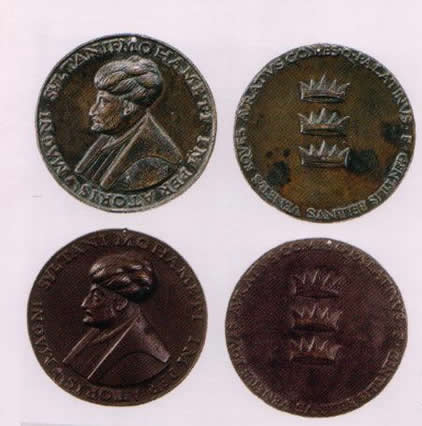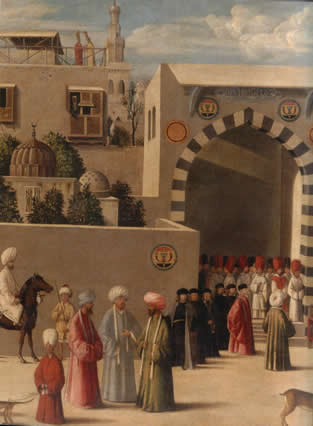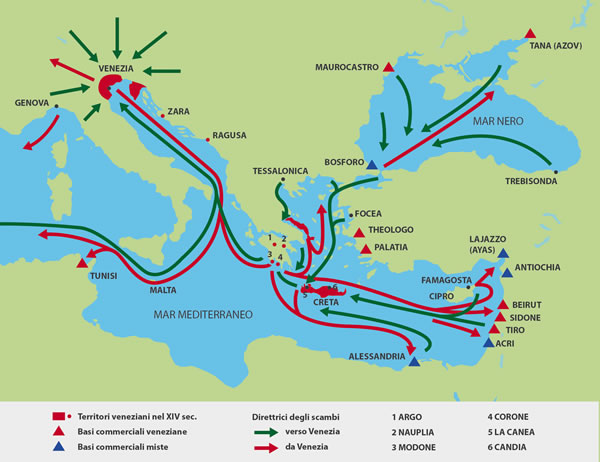There have always been constant, intense administrative, commercial, diplomatic, military and cultural relations between the Republic of Venice and the Ottoman Empire from the late Middle-Ages to the modern age. Their adjacent borders and a common interest in the economic development of resources in the area led to the need for pacific coexistence between these two states and common rules in order to protect this.
Although profoundly different in terms of their institutional organisation and territory, the Ottomans and the Venetians shared administrative styles and decisions aimed at strengthening an economic system where profits were to be made from trade between the two sides of the Mediterranean.
The earliest contacts between the Ottomans and the Venetians took place in the mid 14th Century, when the Ottomans, an emerging power, were busy expanding their borders while the Venetians were engaged in fighting the Republic of Genoa for supremacy in trade with the Levant.
This situation lasted until the middle of the 15th Century, when the Ottomans - by then firmly established in the Balkans, Anatolia and Asia Minor - set out to conquer Constantinople and the Black Sea. During this period, which led to the destruction of the Byzantine State and the gradual marginalization of Genoa, merchants from Serenissima regularly traded with centres under Ottoman rule thanks to trade treaties called amân, 'ahdnâme or imtiyâzât. Before the trade treaties were finally formalised in the 16th Century, rules of trade known as “Capitolazioni” between the two countries were linked to various treaties reflecting the different circumstances and functions, ranging from landing permits and commercial privileges related to specific goods to rules governing life in a relatively large foreign trade colony on Ottoman territory.
When, Mohammed II established the Ottoman capital in Constantinople in 1453, adopting the Byzantine imperial tradition and presenting himself as the only true guarantor and continuator, the Venetian authorities in the city and the large population of merchants took advantage of their great experience in economic cooperation with the sultans, thus assuming leadership in the system of trade with Europe.
However, Mohammed II did not hesitate to encourage Genoese competition (which had already been granted a particularly favourable trade agreement in 1453) on account of the conflicts at the end of the 15th Century between the Empire and the Signoria. The Venetians had to wait until the following year to enjoy the same privileges .
This policy of politically assisted competition was a constant feature of the Ottoman Empire, even in later centuries. Before the war of Cyprus, similar treaties were granted to France and after that conflict even to England and Holland, when Venice’s power seemed destined to suffer a gradual but inexorable decline. In other words, the Ottomans were always willing to promote a balance of power among the trading nations in its territories, trying to avoid the absolute dominance of any nation over the others by political means or customs legislation.
Historians have always split the relations between the Ottoman Empire and Venice into three phases. The first – from the earliest days until the battle of Negroponte (1479), won by the Ottomans – coincided with the Venetians’ desire to avoid direct confrontation with the Sultan’s powerful army, though without abandoning an active strategy in protecting their territories. The second phase – until the outbreak of the War of Candia – saw the emergence of a cautious and preferably neutral role for the Republic in the clashes between Spain and Suleiman the Magnificent and his successor .
During this second phase, the Venetians’ diplomatic skills were sharpened, letting them exploit the legal potential of a period of prolonged peace. During the 16th Century, marked by wars in the Levant and Europe, Venice became a keeper of the status quo. Continuous peace with the Porta (the name used by Venetians for the central government in Istanbul) depended mainly on the Ottomans’ desire for peace, i.e. the decision not to resume their strategy of territorial expansion within the Mediterranean area. This finally took place in 1570 with the outbreak of the Cyprus conflict. During the third phase, the tables were turned as the Ottoman maritime power weakened and it was Venice who adopted an aggressive strategy, becoming engaged in a twenty-year battle in defence of Candia and involved - with varying degrees of fortune - in the last eighteenth-century wars in Morea and North Africa.
On a more strictly commercial level, Venetian merchants enjoyed an exceptionally continuous presence on Eastern markets, even during the longer conflicts when subjects of the Venetian Republic were forced to heavy restrictions, as well as formal embargos and sometimes even the seizure of assets and merchandise.
Any consideration of Venetian trade in the Near East must also take into account trends and evolutions in industrial products. Until the end of the 16th Century, Venice enjoyed undisputed prestige when it came to the manufactured goods popular at the Ottoman court and with the affluent classes in the provinces: woollen cloth and silk fabric (embroidered or otherwise), glass objects, mirrors, jewellery and metals from Germany flowed to the Ottoman coasts via Venice. Many other goods were also traded , including wheat, salt and other basic commodities. Sometimes, if the places these were produced fell within the Ottoman Empire, Venetian merchants acted as the Sultan’s agents, stipulating contracts for the management of salt-marshes, arable fields and even custom houses. This was mainly true along the east coast of the Adriatic, which was quoted in Ottoman documents as Boğaz-i Venedik (the Gulf of Venice), formally recognising the Republic’s maritime dominance.
Even when interest was turned almost exclusively to land annuity (at the end of the 16th Century), thus abandoning active trade, the Republican government knew how to protect and encourage the maritime vocation of the city, allowing for the emergence of new entrepreneurial classes: these established merchant houses throughout the main ports of the Mediterranean and guaranteed trade with Venice until the end of the 18th Century, long after the city’s period of hegemony. The Venetian consuls in Aleppo, Alexandria, Larnaca, Thessaloniki, Durres and even the bàilo in Constantinople received the sad news of the Treaty of Campoformio (1797) at a time when trade was anything but stagnant.
Vera Costantini






